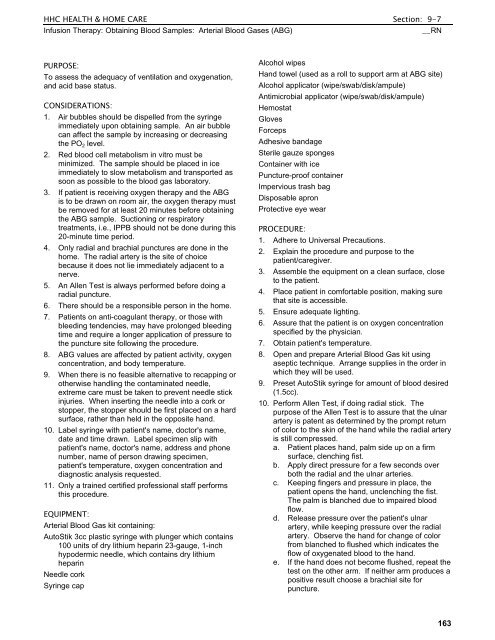HHC Health & Home Care Clinical Policy And
HHC Health & Home Care Clinical Policy And
HHC Health & Home Care Clinical Policy And
Create successful ePaper yourself
Turn your PDF publications into a flip-book with our unique Google optimized e-Paper software.
<strong>HHC</strong> HEALTH & HOME CARE Section: 9-7<br />
Infusion Therapy: Obtaining Blood Samples: Arterial Blood Gases (ABG) __RN<br />
PURPOSE:<br />
To assess the adequacy of ventilation and oxygenation,<br />
and acid base status.<br />
CONSIDERATIONS:<br />
1. Air bubbles should be dispelled from the syringe<br />
immediately upon obtaining sample. An air bubble<br />
can affect the sample by increasing or decreasing<br />
the PO 2 level.<br />
2. Red blood cell metabolism in vitro must be<br />
minimized. The sample should be placed in ice<br />
immediately to slow metabolism and transported as<br />
soon as possible to the blood gas laboratory.<br />
3. If patient is receiving oxygen therapy and the ABG<br />
is to be drawn on room air, the oxygen therapy must<br />
be removed for at least 20 minutes before obtaining<br />
the ABG sample. Suctioning or respiratory<br />
treatments, i.e., IPPB should not be done during this<br />
20-minute time period.<br />
4. Only radial and brachial punctures are done in the<br />
home. The radial artery is the site of choice<br />
because it does not lie immediately adjacent to a<br />
nerve.<br />
5. An Allen Test is always performed before doing a<br />
radial puncture.<br />
6. There should be a responsible person in the home.<br />
7. Patients on anti-coagulant therapy, or those with<br />
bleeding tendencies, may have prolonged bleeding<br />
time and require a longer application of pressure to<br />
the puncture site following the procedure.<br />
8. ABG values are affected by patient activity, oxygen<br />
concentration, and body temperature.<br />
9. When there is no feasible alternative to recapping or<br />
otherwise handling the contaminated needle,<br />
extreme care must be taken to prevent needle stick<br />
injuries. When inserting the needle into a cork or<br />
stopper, the stopper should be first placed on a hard<br />
surface, rather than held in the opposite hand.<br />
10. Label syringe with patient's name, doctor's name,<br />
date and time drawn. Label specimen slip with<br />
patient's name, doctor's name, address and phone<br />
number, name of person drawing specimen,<br />
patient's temperature, oxygen concentration and<br />
diagnostic analysis requested.<br />
11. Only a trained certified professional staff performs<br />
this procedure.<br />
EQUIPMENT:<br />
Arterial Blood Gas kit containing:<br />
AutoStik 3cc plastic syringe with plunger which contains<br />
100 units of dry lithium heparin 23-gauge, 1-inch<br />
hypodermic needle, which contains dry lithium<br />
heparin<br />
Needle cork<br />
Syringe cap<br />
Alcohol wipes<br />
Hand towel (used as a roll to support arm at ABG site)<br />
Alcohol applicator (wipe/swab/disk/ampule)<br />
Antimicrobial applicator (wipe/swab/disk/ampule)<br />
Hemostat<br />
Gloves<br />
Forceps<br />
Adhesive bandage<br />
Sterile gauze sponges<br />
Container with ice<br />
Puncture-proof container<br />
Impervious trash bag<br />
Disposable apron<br />
Protective eye wear<br />
PROCEDURE:<br />
1. Adhere to Universal Precautions.<br />
2. Explain the procedure and purpose to the<br />
patient/caregiver.<br />
3. Assemble the equipment on a clean surface, close<br />
to the patient.<br />
4. Place patient in comfortable position, making sure<br />
that site is accessible.<br />
5. Ensure adequate lighting.<br />
6. Assure that the patient is on oxygen concentration<br />
specified by the physician.<br />
7. Obtain patient's temperature.<br />
8. Open and prepare Arterial Blood Gas kit using<br />
aseptic technique. Arrange supplies in the order in<br />
which they will be used.<br />
9. Preset AutoStik syringe for amount of blood desired<br />
(1.5cc).<br />
10. Perform Allen Test, if doing radial stick. The<br />
purpose of the Allen Test is to assure that the ulnar<br />
artery is patent as determined by the prompt return<br />
of color to the skin of the hand while the radial artery<br />
is still compressed.<br />
a. Patient places hand, palm side up on a firm<br />
surface, clenching fist.<br />
b. Apply direct pressure for a few seconds over<br />
both the radial and the ulnar arteries.<br />
c. Keeping fingers and pressure in place, the<br />
patient opens the hand, unclenching the fist.<br />
The palm is blanched due to impaired blood<br />
flow.<br />
d. Release pressure over the patient's ulnar<br />
artery, while keeping pressure over the radial<br />
artery. Observe the hand for change of color<br />
from blanched to flushed which indicates the<br />
flow of oxygenated blood to the hand.<br />
e. If the hand does not become flushed, repeat the<br />
test on the other arm. If neither arm produces a<br />
positive result choose a brachial site for<br />
puncture.<br />
163







